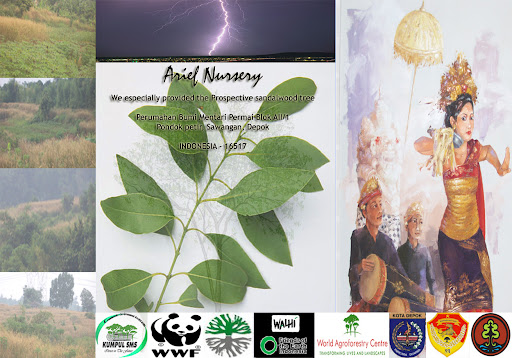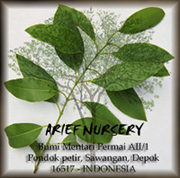
Santalum album L or by the name of the area of the Sandalwood had the limited natural spreading in Indonesia including East Java, East Nusa Tenggara, Sulawesi and the Moluccas. This crop grew good in the height between 50 - 1200 metre dpl, the type of the D climate and E (according to Schmidt-Ferguson) on average the rainfall per the year between 1.100 - 2.000 mm as well as had 14 rain days in 4 driest months.
The Sandalwood crop needed the foster-mother's crop like chilli, the eggplant et cetera, because of being classified as the tree of half of the parasite. In the production of the crop, the Sandalwood tree could be mixt in part with Albizia chinensis, Acacia sp, Cassia siamea, Tamarindus indicus, Pseudium guyava. This crop apart from functioning as the foster-mother also as the patron. Terrace wood was used for the production of sandalwood oil and various handicrafts like the statue, the stick, dubbed as him.
The production of the seed in the seed-bed was needed if in planting was used the seed. If being used the seed in planting, then the seed-bed might not be made. In choosing the location of the seed-bed, the condition for the location that the flat field, close to the source of water and close to the transport, The condition for the environment in accordance with the condition for the place grew the Sandalwood.
The different collection of the Sandalwood seed of each area because of the fruitful season depended on the condition for the area of the place of the growth, but generally in February up until June.
In P. Timor the seed collection could be carried out in March - in June. That was good for the seed, came from the mother of the crop that be aged 20 - 30 years, although the Sandalwood tree has begun to be fruitful in the age 4 years. The seed that has been marked with wana red until brownish.
The tree that his quality good could produce 5 - 10 kg the dry seed. Every time kilogram contained 5000 - 7000 seeds. The seed could be received from the garden personally or bought from the company that was appointed by the Department of Forestry.
Several matters that must be paid attention to in the procurement of the seed in part :
- The seed that has been gathered immediately was encouraged or buried in the field, Because in the period two months in the temperature of the room of the power kecambah him descended 50% and after 5 months 0%.
- The seed came from the tree that his growth was good.
- Clearly the origin he proposed.
- Luxuriant seed skin, shone
- The measuring seed big and healthy.
The prospective sandalwood could be also received from the root cutting, afterwards disapih in the pocket of plastic (polyback). To stimulate the growth of the root, the crop material was given the solution to the hormone (rootone). This method produced the percentage so that was lower than was used the seed. In order to receives the production and the quality of the stand, must be striven for by the use of the good seed. Strewing of the seed in the location of the seed-bed for the production of the prospective Sandalwood must meet the condition as follows :
- Was adjacent to the location of planting and the location environment of seedling cultivation in accordance with the condition that was desired the Sandalwood.Be enough to be available water and young was supervised. The area in accordance with the area of the seed-bed plan that will be developed.
- Penyemaian the seed in bedeng scattered could be used like wood or the plastic basin. The measurement bedeng scattered was adapted to the number of seeds that would disemai and the width of the land that was allocated for the need bedeng scattered. Generally was used 2 x 1 m. or 1 x 1 m. The media scattered was used by the mixture of the layer land processed and soft sand with the comparison 1: 2. Before being used better the media scattered this was mixt with the TSP product with the dose 1 kg TSP to 1 m3 the media. Before the media scattered this ditananami the seed was watered adequate. The seed was buried with the distance 1 x 2 cm or 5 x 5 cm.
- After 7 seed days sprouted. Matters that must be paid attention to in encouraging the Sandalwood as follows : The sandalwood seed disemai together his foster-mother's crop. The foster-mother's crop that was used including chilli. Planting of the seed be as deep as 1 cm afterwards was closed by the soft land or sand. Bedeng scattered was given by the protection. Penyiangan weeds must be done every time. Watering was carried out the morning or in the afternoon 1 - 2 times a day. After kecambah be aged 1 - 2 weeks and his stick began mengayu immediately disapih, together his foster-mother's tree.
- Penyemaian the direct seed to the pocket of this Method plastic was more practical than the method above, because of not needing weaning. The media that was used same like bedeng scattered. The pocket of plastic that was used measuring 8 x 20 cm and thick him 0,04 mm was white or black. Before the pocket of this plastic was filled up by the media, was given small holes in the underside and his edge. His intention to avoid excessive watering water. Before the seed disemai, the media was poured first with adequate water. The seed disemai together his foster-mother's crop in one pocket that already bermedia. The foster-mother's crop that was used chilli.
Matters that must be paid attention to in the production of the seed as follows : The production of the seed was carried out was supervised by the protection In this case could be used the roof from the leaves nipah or sarion the green colour. Planting of the seed be as deep as 1 cm and watering was carried out every day the morning and or in the afternoon until the seed achieved the measurement was ready planted (5 - 7 months). For the seed dipersemaikan must be carried out penyiangan weeds that grew.
Bibit weaning and bedeng scattered. The media that was used for weaning was used by the mixture of the layer land processed and sand with the comparison 3: 1. This media diisikan in pockets of plastic that has been given small holes in the underside and the adequate edge. Before the media was planted the seed, the media was poured adequate. The seed was buried upright carefully, together his foster-mother's crop. Ought to be paid attention to lest his upside down root was folded or perakaran other broken. The process of weaning for 5 - 7 months were carried out was supervised by the protection.
The seed from permudaan Prinsipnya nature almost was the same as the method of seed weaning from bedeng scattered. That ought to be paid attention to the nature doll that was used maximal leafy 4 - 5. To reduce evaporation of the leaves was cut off by half of it the too long upside down Root could be cut off before the doll was buried/disapih.
The Maintenance.
The maintenance activity that must be carried out in part take the form of : Watering, fertilising and the eradication of the pest and the illness. Watering was with clean water carried out by 2 times a day. The watering method should not dilangsung was sprayed with water, but the wet growth media evenly. After being 4 weeks old, the young crop was fertilised by NPK with the dose 0,1 gram the seed or 0.5 teaspoons. Further fertilising was given every time 2 - 3 weeks until be aged 8 - 10 weeks. The normal crop pest attacked the seed-bed was the mouse, the grasshopper and the cricket. Whereas the common illness attacked was the illness bulir, leaves rust, et cetera. To prevent the possibility of the existence of the pest attack and the illness, the seed-bed must be sprayed by using pesticide, the fungicide as well as was guarded by his cleanliness
Copied from:
Teknik Pembuatan Tanaman Cendana, Directorate Tanaman Industri, Directorate General Reboisasi and Rehabilitation of the Land, Departemen of Republic of Indonesia Forestry.







